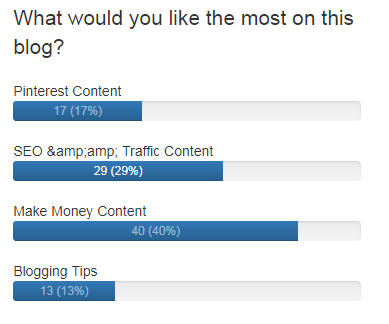One of the reasons many bloggers struggle is the fact that they don’t know how to narrow their niches and write for a specific group of readers.
It’s always a big challenge for beginners to choose a blogging topic. For the most part, they are advised to begin broad, covering different related topics, then gradually figure out what’s hot with time and focus on those hot topics.
Hot in the sense that their readers pay attention and interact more in those topics. But this has turned out to be a bad piece of advice for many. They keep throwing their feet in the dark, not knowing what’s hot cake or not hot on their blogs.
As the struggle without success continues, the conclusion blois always that blogging is hard. It’s saturated. And you find them quitting.
Table of Contents - What is covered in this post
Blogging for everyone is blogging for no one.
The baddest mistake you are going to make as a blogger is to want to be everywhere. I have seen blogs covering tens of different topics at once.
Don’t get me wrong…
If you are The Huffington Post, the Techcrunch or the Engadget type with a huge team and the necessary resources, you can always spread out. After all, you have what it takes.
But if you are a solo blogger, or a small team with the burning desire to setup a thriving content marketing business, gambling with contents on a broad range of topics is tantamount to shooting your own leg.
I made that mistake in the beginning when I thought the best approach was to fill my menus with different topics. I ended up burning and wasting energy and writing for space.
But a time came when I found out I had to narrow down. That I did and the result was pleasantly the opposite. Yes.
While reducing and getting rid of some topics, my community was growing bigger and bigger. So the approach to expand your community (as a small team or solo blogger) is to focus on serving a specific group of readers.
Serving a specific group or niche does’t directly mean you are writing for few readers. I know some niches are less popular. But generally, focusing on a specific industry grows your community in that industry.
You get to be well known, and become the go-to blog when it comes to some industry related information.
When it comes to reading actionable SEO materials, I often turn to backlinko, searchengineland, searchenginejournal, etc because these have established themselves as leaders in the industry.
How to know the HOT TOPICS on your blog. What to do with them!
Overlapping topics
That’s correct.
Some niches blend into each other. Here on my blog, I really don’t write on social media. I do write on SEO and other traffic generating tips. But Pinterest is considered a social media/Search engine of its kind.
So being a source of traffic and a powerful visual search engine, I have a category dedicated to Pinterest posts and it’s getting attention.
Most bloggers in the content marketing niche cover a lot of other related topics. These is because these all fit into each other and it makes sense to cover them. But you still have to niche down.
Niching down – Focusing on what readers really want
This is a serious step in building your content marketing business but it’s like many marketers still don’t get it.
However, we all want to focus on the market segment that brings the best ROI. Some contents on our blogs are doing quite better. Not because they got more of our attention though. It’s simply because our readers find some connection inside.
Now, I’m going to give you some great tips to help you identify those areas on your blog that attract the most attention. You are going to see from my practical examples, links and menu items that are receiving the most clicks and those that are like being avoided by readers.
Once you identify these sleeping elements, you may want to shift your energy away from them and focus on sections that are already driving results.
1 – Use heatmap tool
This is basically my best way to sit on my bench, look over the shoulders of my readers, and see the exact areas of my blog that attracts their clicks.
Heatmap tools provide great insight into how your users interact with your blog, from their landing to exit. The provide an overlay on your pages, showing areas that attract more attention and clicks.
Using this tool to monitor menu and category items on your blog, you will easily draw a conclusion on which elements is attractive and which isn’t:

Taking this as an active example, the yellow spots represents clicks on my menu. Needless to say SEO and Blogging Tips are hot topics on this blog, then followed by Make Money and Pinterest.
But what did this look like in the few years past?

Make money has always been a popular topic on this blog. This is followed by Web Traffic (and SEO is a huge section of it). While SEO didn’t receive any attention from my readers years ago, this has grown to be the main attraction.
Let’s use something else to find out more
4 – Polls and survey
This is a way of asking your readers direct questions on what they would want to see on your blog. A poll that has been on this blog for a couple of weeks got this report from the readers:

40% stood for Make Money Content. This was followed by SEO with 29%. Then Pinterest and Blogging Tips came on respectively. Though the general Poll participation wasn’t a big ideal, the few readers that participated provided some vital data.
Following these two methods, I could go on to serve my audience with more engaging content. But If I still have to niche down, it would be easier to decide on slowing down on Blogging Tips and Pinterest Content.
3 – Most Commented Topics
Not all blogs are open for discussion. But if yours is, this section could help with a glimpse of what could be popular in your community.
Some articles in some topics may be constantly boring. But if you are receiving tons of awesome comments in some topics, you may not need a spiritualist to tell you to go deeper in that topic.
4 – Use Analytics Tools
A good example of Analytics Tools is Google Analytics.
These help with data to know the sources of readers to your site, the pages viewed and movement from one page to the other.
General traffic channels are:
- Natural (SEO)
- Social Media
- Referral
- Direct
Taking a closer look at these channels will drop some lights into what seems to be working for you. digging deep into Social Media for instance will help you understand which Social Media platform provides the most of your traffic and which topics are hot.
Is this really important?
Yes it is!
I mentioned in the beginning it’s important to blog to help some people. If you ain’t just there to blog as a bobby, your blogging won’t make sense if it doesn’t provide solutions to your readers.
The best way to meet the needs of your readers is to know what they want. These are just some of the steps to take to come back with somewhat accurate data to help you target the right people, help them with answers while their actions on your blog cause you to earn money.
I hope this was helpful. Let me know what you think in the comment box.

Comments are closed.